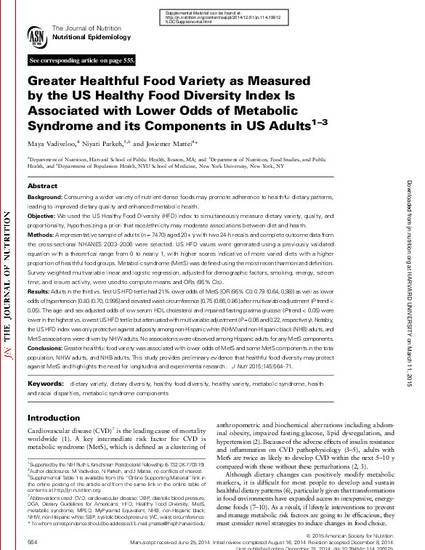
Article
Greater Healthful Food Variety as Measured by the US Healthy Food Diversity Index Is Associated with Lower Odds of Metabolic Syndrome and its Components in US Adults.pdf
The Journal of Nutrition
(2014)
Abstract
Background: Consuming a wider variety of nutrient-dense foods may promote adherence to healthful dietary patterns, leading to improved dietary quality and enhanced metabolic health.
Objective: We used the US Healthy Food Diversity (HFD) index to simultaneously measure dietary variety, quality, and proportionality, hypothesizing a priori that race/ethnicity may moderate associations between diet and health.
Methods: A representative sample of adults (n = 7470) aged 20+ y with two 24-h recalls and complete outcome data from the cross-sectional NHANES 2003–2006 were selected. US HFD values were generated using a previously validated equation with a theoretical range from 0 to nearly 1, with higher scores indicative of more varied diets with a higher proportion of healthful food groups. Metabolic syndrome (MetS) was defined using the most recent harmonized definition. Survey-weighted multivariable linear and logistic regression, adjusted for demographic factors, smoking, energy, screen time, and leisure activity, were used to compute means and ORs (95% CIs).
Results: Adults in the third vs. first US HFD tertile had 21% lower odds of MetS [OR (95%CI): 0.79 (0.64, 0.98)] as well as lower odds of hypertension [0.83 (0.70, 0.995] and elevatedwaist circumference [0.75 (0.66, 0.86] aftermultivariable adjustment (P-trend <0.05). The age- and sex-adjusted odds of low serum HDL cholesterol and impaired fasting plasma glucose (P-trend < 0.05) were lower in the highest vs. lowest US HFD tertile but attenuated with multivariable adjustment (P = 0.06 and 0.22, respectively).Notably, the US HFD index was only protective against adiposity among non-Hispanic white (NHW) and non-Hispanic black (NHB) adults, and MetS associations were driven by NHW adults. No associations were observed among Hispanic adults for any MetS components.
Conclusions: Greater healthful food variety was associated with lower odds of MetS and some MetS components in the total population, NHW adults, and NHB adults. This study provides preliminary evidence that healthful food diversity may protect against MetS and highlights the need for longitudinal and experimental research.
Keywords
- dietary variety,
- dietary diversity,
- healthy food diversity,
- healthy variety,
- metabolic syndrome,
- health and racial disparities,
- metabolic syndrome components
Disciplines
Publication Date
December 31, 2014
DOI
10.3945/jn.114.199125
Citation Information
Maya Vadiveloo, Niyati Parekh and Josiemer Mattei. "Greater Healthful Food Variety as Measured by the US Healthy Food Diversity Index Is Associated with Lower Odds of Metabolic Syndrome and its Components in US Adults.pdf" The Journal of Nutrition Vol. 145 (2014) p. 564 - 571 ISSN: 1541-6100 Available at: http://works.bepress.com/maya-vadiveloo/3/
